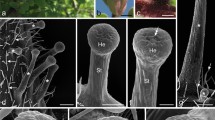Summary
The trichomes ofMonarda extrude up to 450 μm3 of an aqueous solution per minute. Their head cells contain nuclei of a volume more than twice that of common epidermal cells, up to 800 dictyosomes, and only a few mitochondria and plastids. The water is extruded by way of the Golgi vesicles. A dictyosome yields one cisterna per minute which is replaced by a new one on the opposite side, so that in about eight minutes the entire dictyosome is renewed.
Zusammenfassung
Die Trichome vonMonarda fistulosa sezernieren bis 450 μm3 einer wäßrigen Flüssigkeit pro Minute. Ihre Köpfchenzellen besitzen Zellkerne, die mehr als doppelt so voluminös als die der normalen Epidermiszellen sind, nur wenige Mitochondrien und Piastiden und über 800 Dictyosomen. Die Dictyosomen-Vesikeln transportieren die Flüssigkeit nach außen. Dabei wird pro Minute eine Zisterne aufgelöst und eine neue produziert, so daß ein Dictyosom in ca. acht Minuten vollständig erneuert ist.
Similar content being viewed by others
Literatur
Amelunxen, F., 1964: Elektronenmikroskopische Untersuchungen an den Drüsenhaaren vonMentha piperita L. Planta med.12, 121–139.
Brown, R. M., 1969: Observations on the relationship of the Golgi apparatus to wall formation in the marine chrysophycean alga,Pleurochrysis scherffelii Pringsheim. J. Cell Biol.41, 109–123.
Curran, P. F., andJ. R. Macintosh, 1962: A model system for biological water transport. Nature193, 347–348.
Haberlandt, G., 1894: Über Bau und Function der Hydathoden. Ber. dtsch. bot. Ges.12, 367–378.
Klink, R., 1971: über die Epidermisdifferenzierungen des Blattes vonMonarda fistulosa (Lamiaceae). Hausarbeit in Biologie, Univ. Hamburg.
Lepeschkin, W. W., 1906: Zur Kenntnis des Mechanismus der aktiven Wasserausscheidung der Pflanzen. Beih. Bot. Ctrbl., I. Abt.19, 409–452.
Luft, J. H., 1961: Improvements in epoxy embedding methods. J. biophys. biochem. Cytol.9, 409–414.
Nagl, W., 1968: Der mitotische und endomitotische Kernzyklus beiAllium carinatum.; Struktur, Volumen und DNS-Gehalt der Kerne. Öst. bot. Z.115, 322–353.
Pfeffer, W., 1877: Osmotische Untersuchungen. Studien zur Zellmechanik. Leipzig: Engelmann.
Rambourg, A., andC. P. Leblond, 1967: Electron microscope observations on the carbohydrate-rich cell coat present at the surface of cells in the rat. J. Cell Biol.32, 27–53.
Schnepf, E., 1961: Quantitative Zusammenhänge zwischen der Sekretion des Fangschleimes und den Golgi-Strukturen beiDrosophyllum lusitanicum. Z. Naturforsch.16 b, 605–610.
—, 1965: Licht- und elektronenmikroskopische Beobachtungen an den Trichom-Hydathoden vonCicer arietinum. Z. Pflanzenphysiol.53, 245–254.
—, 1968: Zur Feinstruktur der schleimsezernierenden Drüsenhaare auf der Ochrea vonRumex undRheum. Planta (Berl.)79, 22–34.
—, 1969: Sekretion und Exkretion bei Pflanzen. Protoplasmatologia VIII/8, Wien-New York: Springer-Verlag.
—, 1972: Tubuläres endoplasmatisches Reticulum in Drüsen mit lipophilen Ausscheidungen vonFicus, Ledum undSalvia. Biochem. Physiol. Pflanzen (BPP)163, 113–125.
—, undW. Koch, 1966 a: Golgi-Apparat und Wasserausscheidung beiGlaucocystis. Z. Pflanzenphysiol.55, 97–109.
— —, 1966 b: Über die Entstehung der pulsierenden Vacuolen vonVacuolaria virescens (Chloromonadophyceae) aus dem Golgi-Apparat. Arch. Mikrobiol.54, 229–236.
Scora, R. W., 1967: Interspecific relationship in the genusMonarda (Labiatae). Univ. Calif. Publ. Bot.41, 1–59.
Tschermak-Woess, E., undG. Hasitschka, 1954: Über die endomitotische Polyploidisierung im Zuge der Differenzierung von Trichomen und Trichozyten bei Angiospermen. Öst. bot. Z.101, 79–117.
—, undDoležal-Janisch, 1956: Rhythmisches Kernwachstum während der mitotischen Interphase vonVicia faba. Öst. bot. Z.103, 588–599.
Weber, U., undJ. Deufel, 1951: Zur Cytologie der Drüsenhaare vonAchillea millefolium. Arch. Pharmaz.284, 318–323.
Ziegler, H., 1965: Die Physiologie pflanzlicher Drüsen. Ber. dtsch. bot. Ges.78, 466–477.
Author information
Authors and Affiliations
Additional information
Fräulein G.Eikenberg danke ich für wertvolle Mitarbeit, der Deutschen Forschungsgemeinschaft für finanzielle Unterstützung.
Rights and permissions
About this article
Cite this article
Heinrich, G. Die Feinstruktur der Trichom-Hydathoden vonMonarda fistulosa . Protoplasma 77, 271–278 (1973). https://doi.org/10.1007/BF01276763
Received:
Revised:
Issue Date:
DOI: https://doi.org/10.1007/BF01276763




